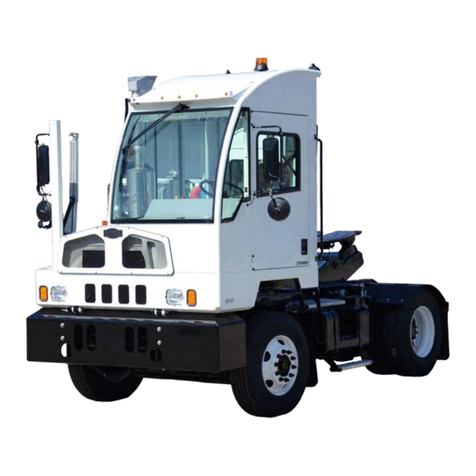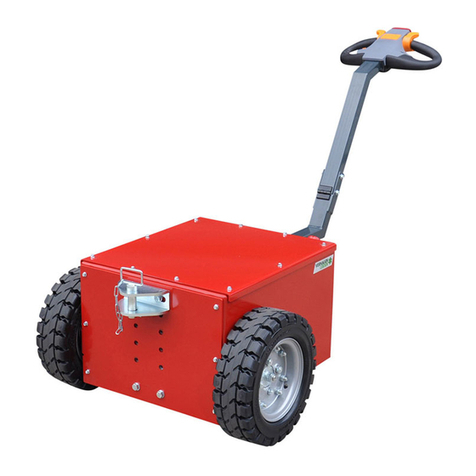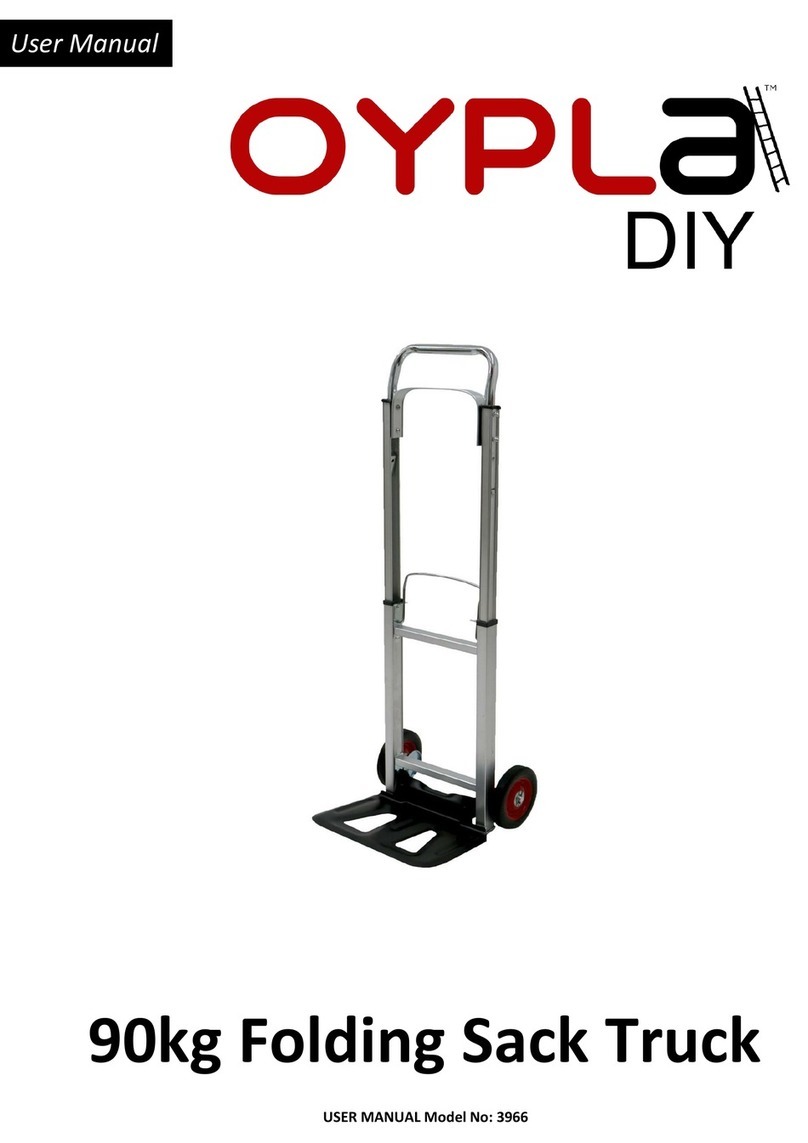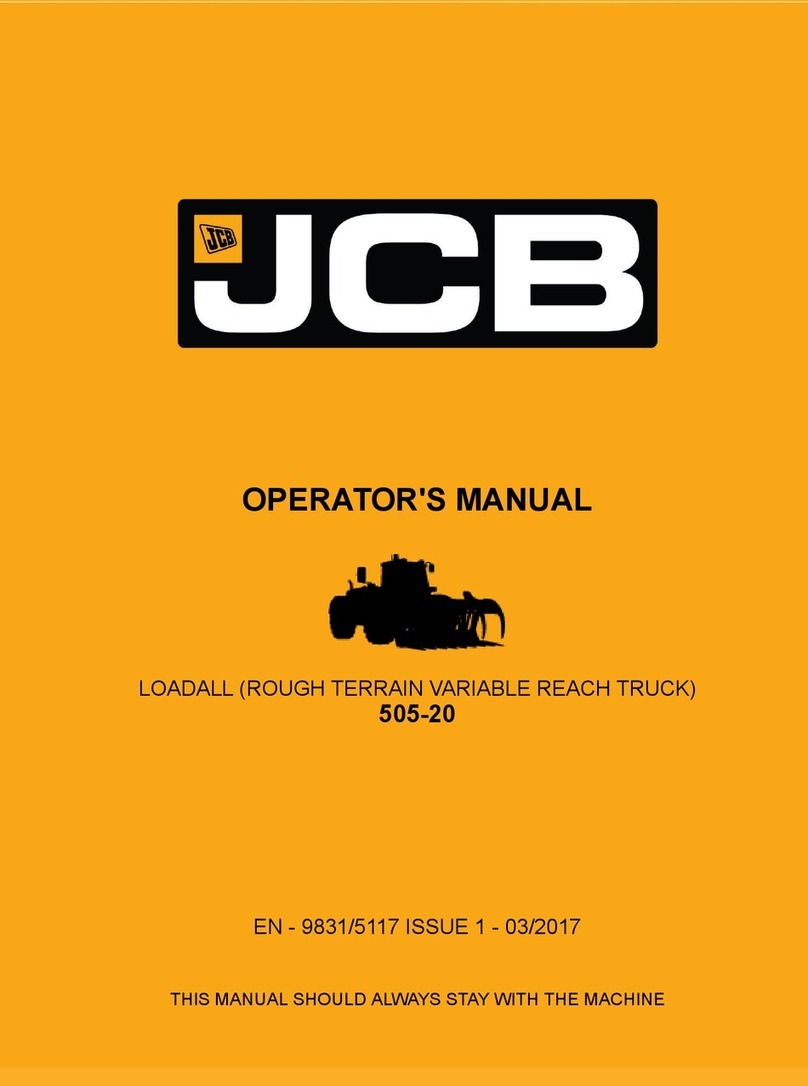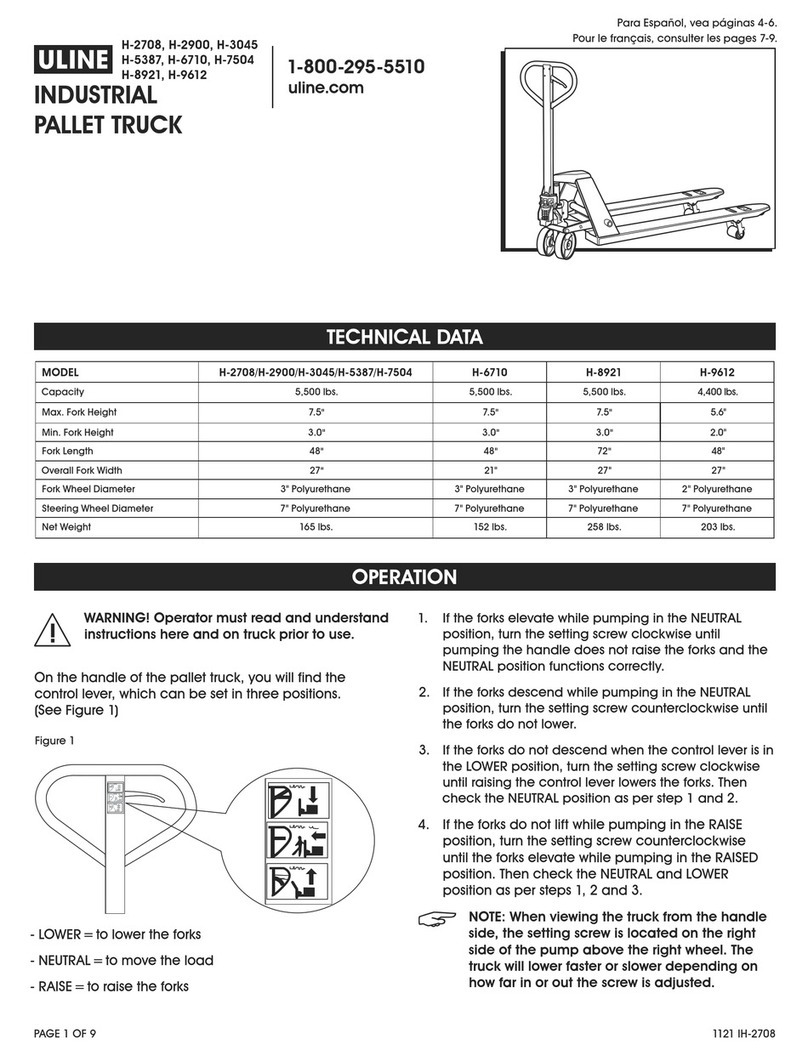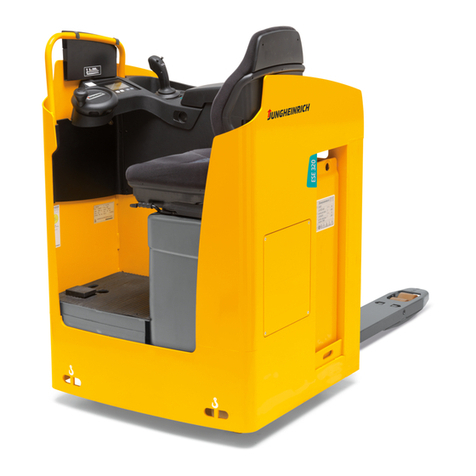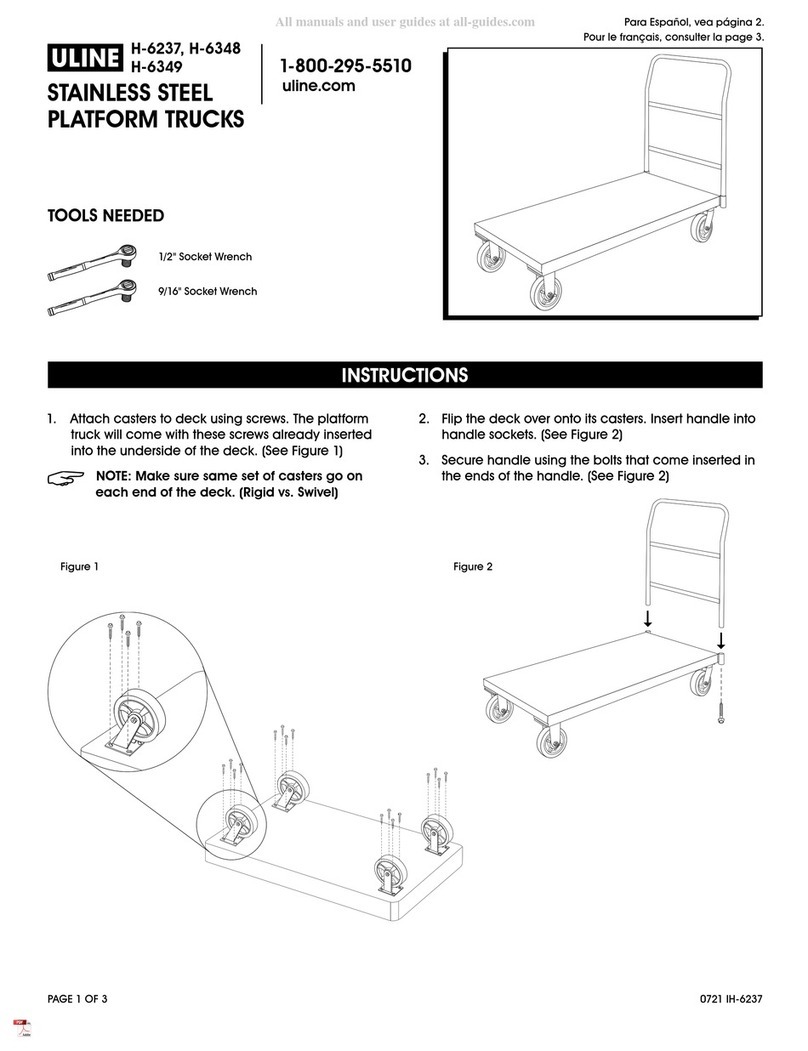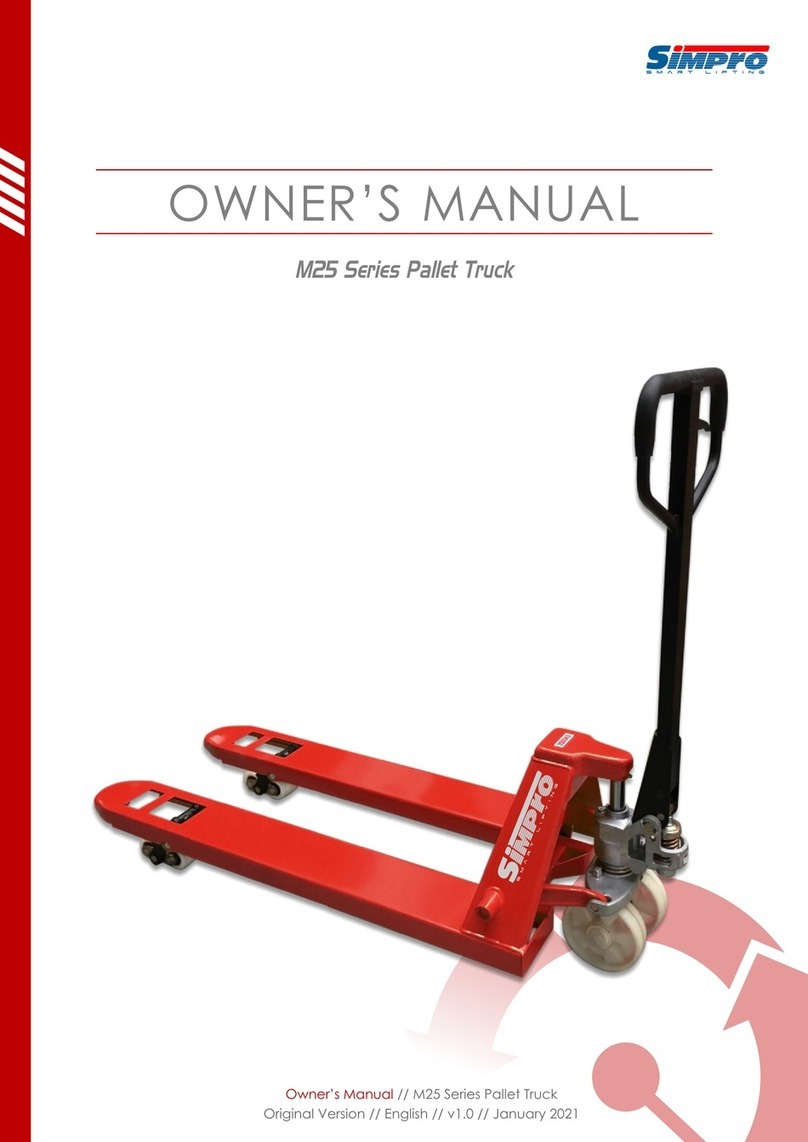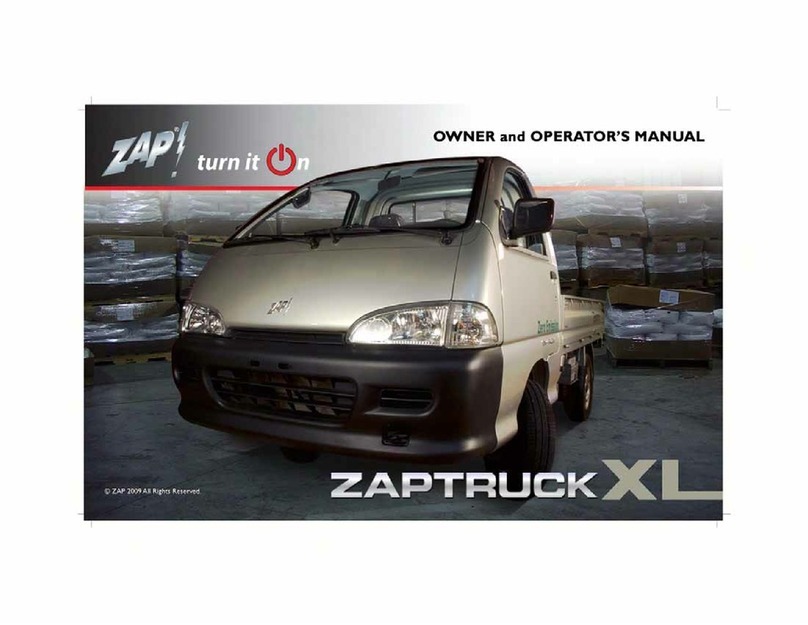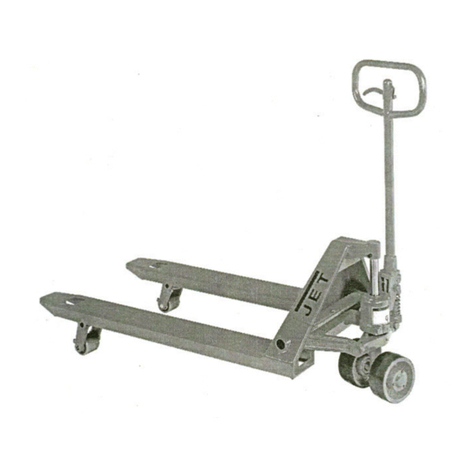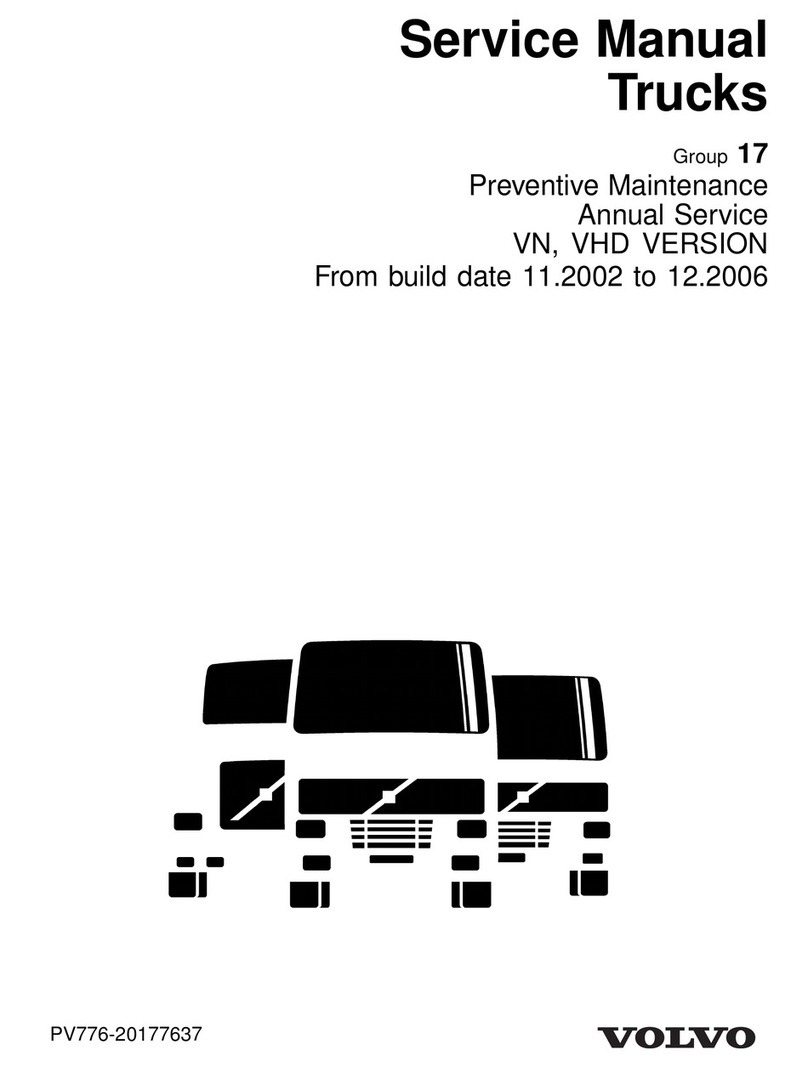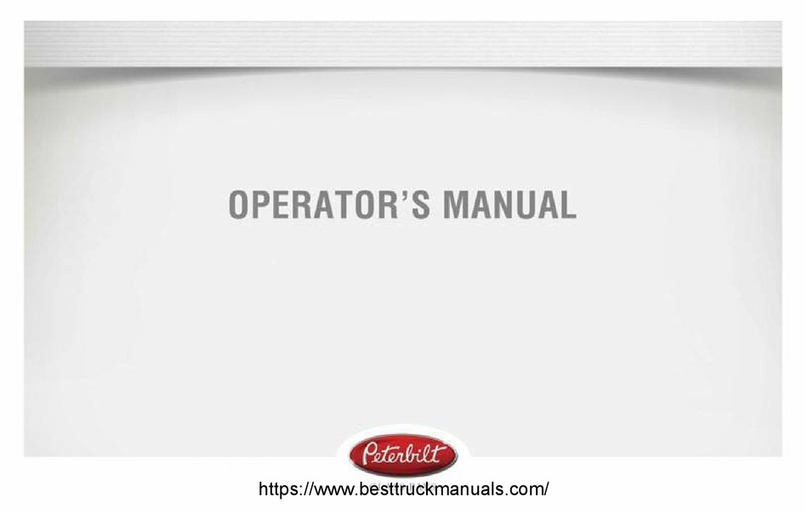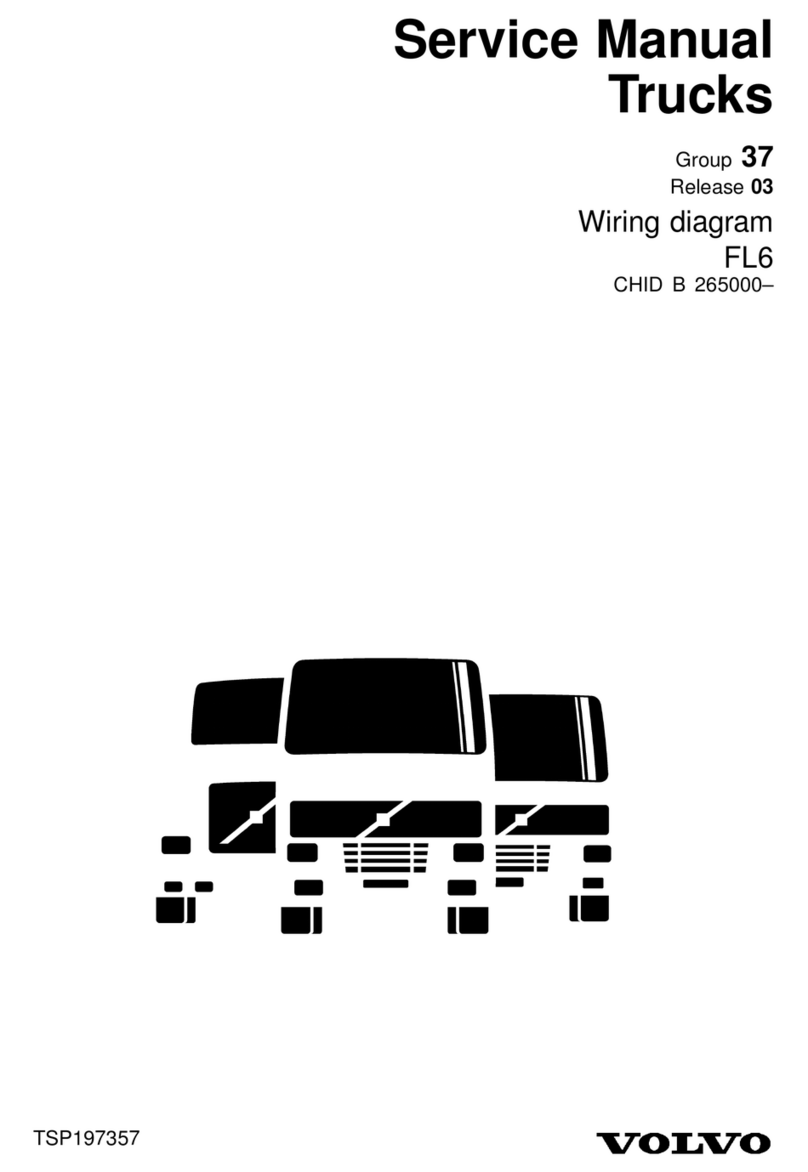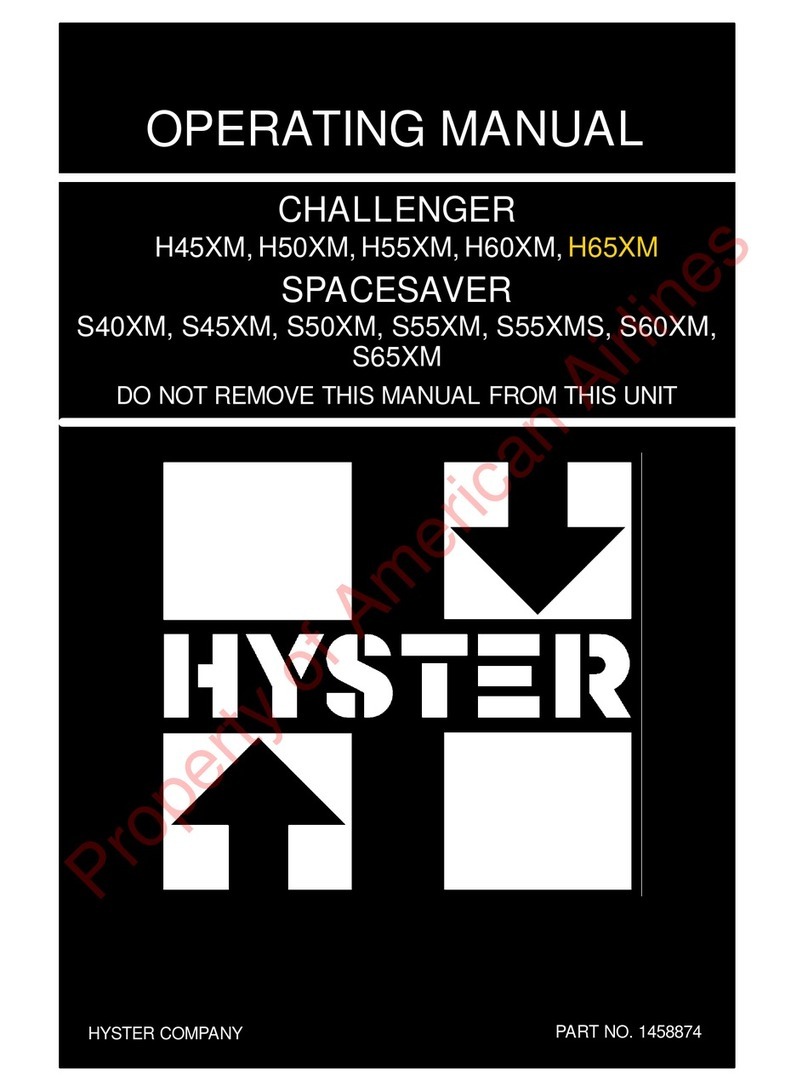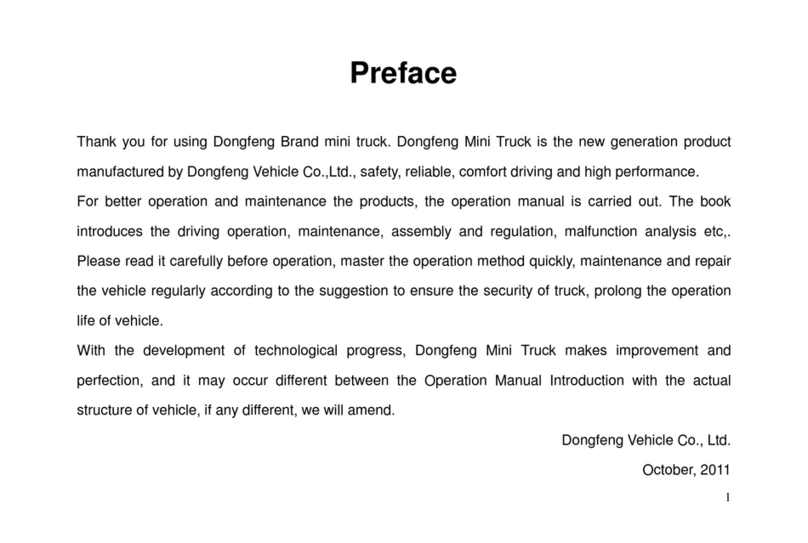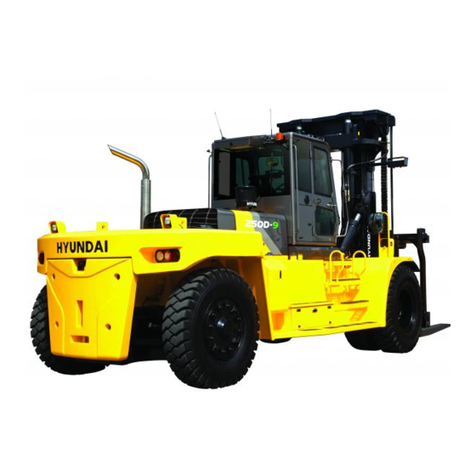AUTOCAR ACTT Xspotter 2018 User manual

autocartruck.com
Preventive Maintenance
AWE 00006 Rev. 005a
ACTT
Service
Manual


Preventive Maintenance
Important Notice
This Service Manual has been prepared by Autocar Industries, LLC (“Autocar”) for reference and use
by technicians who have been trained to repair and service Autocar products.
Autocar has exercised reasonable care and diligence to present accurate, clear and complete
information and instructions regarding the techniques and tools required for maintaining, repairing
and servicing Autocar products. However, despite the care and effort taken in preparing this general
Service Manual, Autocar makes no representations or warranties that (a) the Service Manual or any
explanations, illustrations, information, techniques or tools described herein are either accurate,
complete or correct as applied to a specic Autocar product, or (b) any repairs or service of a
particular Autocar product will result in a properly functioning unit.
The vehicles and components referenced in this manual are under continuous development. Vehicles
and components produced after the manual release date may therefore have different specications
and repair methods.
This manual covers service of Autocar products as congured when they leave the factory. This
manual does not cover or apply to Autocar products that have been modied after leaving Autocar’s
factory. Autocar is not liable for any damage or failure of components added by a body builder or any
other modication company not contracted by Autocar, or the failure of original components caused
by any modication or alteration of the Autocar product.
Autocar is dedicated to protecting the environment. When servicing Autocar products, please dispose
of all removed material, oils and coolant in an environmentally responsible manner.
Autocar Industries, LLC
Hagerstown, Indiana, U.S.A.
Document Number: AWE 00192 Rev. 000
Copyright © 2018 Autocar Industries, LLC
All rights reserved. No part of this publication may be reproduced, stored in a retrieval system or
transmitted in any form by any means - electronic, mechanical, photocopying, recording or otherwise
- without the prior written consent of Autocar.

This page left blank intentionally.

AWE 00192 Rev. 000 TOC-1
877-973-3486
Preventive Maintenance
Table of Contents
Safety Denitions.................................................................................................................... 3
Safety Information .................................................................................................................. 3
General Safety ...................................................................................................................... 3
Lifting..................................................................................................................................... 4
Jacking Up the Vehicle.......................................................................................................... 4
Pneumatic (Compressed Air) Components ........................................................................... 4
Hydraulic Components.......................................................................................................... 4
Working on CNG/LNG Trucks ............................................................................................... 5
Working on CNG Fuel Systems ............................................................................................ 5
CNG/LNG Safety................................................................................................................... 5
Welding and Hot Work Near CNG and LNG Trucks.............................................................. 5
CNG Cylinders ...................................................................................................................... 5
CNG Fuel Container Pressure Relief Devices (PRDs).......................................................... 6
Eye, Ear and Skin Protection ................................................................................................ 6
Testing the Equipment........................................................................................................... 6
Road Testing the Vehicle....................................................................................................... 7
While Servicing the Vehicle................................................................................................... 8
Ground Straps and Antistatic Mats........................................................................................ 8
Power Steering...................................................................................................................... 8
Lockout / Tagout Procedures ................................................................................................ 8
Introduction............................................................................................................................. 9
PREVENTIVE MAINTENANCE PROGRAM............................................................................ 9
A Inspection .......................................................................................................................... 9
B Inspection........................................................................................................................... 9
C Inspection .......................................................................................................................... 9
D Inspection .......................................................................................................................... 9
INSPECTION 150 HRS INTERVAL........................................................................................ 10
Exterior Inspection (150 Hours)........................................................................................... 10
Walk-Around Inspection ...................................................................................................... 10
Fuel System ........................................................................................................................ 13
Braking System ................................................................................................................... 15
Electrical System................................................................................................................. 16
Electrical System................................................................................................................. 16
Engine Compartment .......................................................................................................... 17
Cooling System ................................................................................................................... 18
Intake Air Piping .................................................................................................................. 19

877-973-3486 AWE 00192 Rev. 000TOC-2
ACTT Xspotter Service Manual
Under Tractor Inspection (150 Hours).................................................................................. 19
Description ........................................................................................................................... 19
Lubrication............................................................................................................................ 20
Steering and Suspension ..................................................................................................... 22
Interior and Instrumentation................................................................................................. 23
Road Test (150 Hours) ......................................................................................................... 27
Post Road Test Inspection (150 Hours)................................................................................ 29
Inspection 300 Hrs Interval ................................................................................................... 29
Walk-Around Inspection (300 Hours) ................................................................................... 29
Cooling System Service........................................................................................................ 32
Coolant Drain and Fill Deaeration Procedure....................................................................... 32
Complete Cooling System Maintenance Procedures........................................................... 34
Fan Clutch Service................................................................................................................. 40
Fan Drive Inspection ............................................................................................................ 40
Additional Checks for Two-Speed Fan Drives...................................................................... 42
Air Conditioning Refrigerant ................................................................................................. 42
Under Tractor Inspection (300 Hours).................................................................................. 42
Road Test (300 Hours) ......................................................................................................... 43
Post Road Test Inspection (300 Hours)................................................................................ 44
Inspection 1,200 Hours Interval............................................................................................ 44
Description and Operation (1,200 Hours)............................................................................. 44
Walk-Around Inspection (1,200 Hours) ................................................................................ 45
Under Tractor Inspection (1,200 Hours)............................................................................... 45
Inspection 2,400 Hours Interval............................................................................................ 46
Description and Operation (2,400 Hours)............................................................................. 46
Walk-Around Inspection (2,400 Hours) ................................................................................ 47
Brake System....................................................................................................................... 47
Under Tractor Inspection (2,400 Hours)............................................................................... 47
Preventive Maintenance Intervals ........................................................................................ 48
Special Torque Chart ............................................................................................................. 51
Lubricant and Fluid Requirements ....................................................................................... 52
Chassis Lubrication Chart (Top View) ................................................................................. 53
Chassis Lubrication Chart (Bottom View)........................................................................... 54

AWE 00192 Rev. 000 3
877-973-3486
Preventive Maintenance
SAFETY DEFINITIONS
The following safety indicators are used in this
manual:
DANGER
DANGER indicates a hazardous situation
which, if not avoided, will result in death
or serious injury or damage to equipment
or other property.
WARNING
WARNING indicates a hazardous situation
which, if not avoided, could result in
death or serious injury or damage to
equipment or other property.
CAUTION
CAUTION indicates a hazardous situation
which, if not avoided, may result in
minor or moderate injury or damage to
equipment or other property.
NOTICE
NOTICE is used to address practices not
related to physical injury which, if not
complied with, may result in damage to
equipment or other property.
SAFETY
INSTRUCTIONS
Safety instructions (or equivalent)
indicate specic safety-related
instructions or procedures.
SAFETY INFORMATION
Ensure safe working conditions and
procedures at all times. Read and understand
this entire manual before servicing the vehicle.
You must be thoroughly trained and familiar
with the vehicle before working on it. This
equipment can cause severe injury if not
properly used and maintained.
Safety procedures are for your protection. Do
not operate the vehicle until you have read and
understood the Operator Manual supplied with
the vehicle.
General Safety
There is no substitute for common sense and
careful practices in the workplace. Improper
practices or carelessness can cause burns,
cuts, mutilation, asphyxiation, other bodily
injury or death. The sections that follow provide
general safety precautions and guidelines.
Additional safety precautions are listed in
specic procedures when they apply. Read and
understand all of the safety precautions and
guidelines before performing any repair.
The technician performing maintenance repairs
or service on Autocar products must (a) inspect
the vehicle for abnormal wear and damage,
(b) choose a repair procedure which will not
endanger his/her safety, the safety of others,
the vehicle or the safe operation of the vehicle
and (c) fully inspect and test the Autocar
product to ensure that the repair or service
of the Autocar product has been properly
performed.
Autocar is dedicated to protecting the
environment. When servicing Autocar products,
please dispose of all removed material, oils
and coolant in an environmentally responsible
manner.

877-973-3486 AWE 00192 Rev. 0004
ACTT Xspotter Service Manual
WARNING
NEVER service any part of the fuel
system while smoking or in the presence
of ames, sparks or hot surfaces.
Clean up fuel spills immediately. Fuel
leaked or spilled onto hot surfaces or
electrical components can cause a re.
Before working in or around the vehicle,
apply the parking brake, block the wheels
and put the transmission in NEUTRAL.
WARNING
Immediately replace safety decals if they
become damaged, unreadable or missing.
Contact Autocar for replacement decals
when required.
Lifting
Use a hoist or other assistance when lifting
components that weigh 50 lb. (23 kg) or more.
Make sure all lifting devices such as chains,
hooks or slings are in good condition and have
the correct capacity. Make sure hooks are
positioned correctly. ALWAYS use a spreader
bar when necessary. The lifting hooks MUST
NOT be side loaded.
Jacking Up the Vehicle
NEVER work under a vehicle supported only
by jacks. Jacks can slip out from under the
vehicle or fall over. ALWAYS use jack stands
under the vehicle. Failure to do so can result in
the vehicle falling.
The Antilock Brake System (ABS) MUST be
disabled on vehicles equipped with Automatic
Traction Control (ATC) prior to jacking up the
vehicle and placing it on jack stands. If the ABS
is not disabled and one of the wheels starts to
spin, the ATC will compensate and the vehicle
may come off the jack and/or jack stands.
Refer to the “Antilock Braking System
Service Manual - AWE 00178 Rev. 000” for
information on disabling the ABS system.
Pneumatic (Compressed Air)
Components
DANGER
Pneumatic components such as air
reservoirs and park brake chambers
store compressed air and can separate
violently during disassembly or removal.
Before servicing any part of the
pneumatic (air) system, completely
release the compressed air from the
entire system.
Stay clear when inating or deating air
bags. Drain ALL air reservoirs and ALL
air suspension components including
auxiliary, tag or pusher axle suspensions
before working under or around a vehicle.
Hydraulic Components
DANGER
Hydraulic systems and fuel injection
systems can operate under extremely
high pressures and can remain
pressurized long after shutdown. Before
servicing any part of the hydraulic system
or fuel injection system, carefully relieve
the pressure completely. Escaping uid
under high pressure can penetrate the
skin causing severe injury. NEVER check
for leaks using your hand.
To pinpoint the origin of the leak use a
mirror, a piece of wood or cardboard held
with long-nose pliers in the vicinity of the
leak.

AWE 00192 Rev. 000 5
877-973-3486
Preventive Maintenance
Working on CNG/LNG Trucks
SAFETY
INSTRUCTIONS
If you store or dispense Compressed
Natural Gas (CNG) or Liqueed Natural
Gas (LNG), or if you work on CNG or
LNG trucks, your location must be
fully compliant with applicable codes,
regulations and standards, including
National Fire Protection Associate (NFPA)
codes, Society of Automotive Engineers
(SAE) standards, American National
Standards Institute (ANSI) Natural Gas
Vehicle (NGV) standards, the United
States Code of Federal Regulations (CFR)
and your state and local re and other
applicable codes (including, for example,
the California Code of Regulations and
the Texas Administrative Code).
Contact your local re department for
guidance and additional compliance
information.
Technicians working on Autocar trucks
with CNG or LNG engines must be trained
in the proper repair of CNG and LNG
trucks and engines and the safe storage
and dispensing of CNG and LNG.
Working on CNG Fuel Systems
WARNING
CNG fuel systems include a high pressure
(3600 psi [24 820 kPa]) system for fuel
storage and a low pressure system (125
psi [860 kPa]) for consumption by the
engine. Understanding the characteristics
of CNG and how the fuel system works
will prevent injury and damage to persons
and property.
Attempting to operate or maintain any
CNG fuel system without proper training
is dangerous. Complete training and
consult instructional bulletins from the
CNG system suppliers, such as Agility
Fuel Systems’ Field Service Bulletin:
Safely Working on CNG Fuel Systems.
CNG/LNG Safety
WARNING
Welding and Hot Work Near CNG and
LNG Trucks
Welding, grinding and other “hot work”
can be safely performed on or near a CNG
or LNG vehicle, but certain precautions
must be followed. Understand and
perform the necessary precautions
provided by the CNG and LNG system
suppliers, such as Agility Fuel Systems’
Field Service Bulletin: Welding and Hot
Work Precautions Near CNG and LNG
Vehicles.
CNG Cylinders
WARNING
CNG fuel containers must meet Federal
Motor Vehicle Safety Standard (FMVSS)
304 (Compressed Natural Gas Fuel
Container Integrity) and/or ANSI/
CSA NGV2 (Basic Requirements for
Compressed Natural Gas Vehicle Fuel
Containers). Both standards specify a
detailed visual examination every three
years.
Ensure that every truck owner completes
the required inspections, in accordance
with the applicable standards and other
resources, such as the Clean Vehicle
Education Foundation and NGVAmerica’s
Compressed Natural Gas (CNG)
Container Visual Inspection Advisory.

877-973-3486 AWE 00192 Rev. 0006
ACTT Xspotter Service Manual
FMVSS 304 also requires that cylinders
not be used after the end of life (EOL)
date provided on the tank label. The
EOL date is also displayed in the
engine compartment and at the fueling
connection of each truck. If there is any
question as to proper decommissioning
of a cylinder, contact the manufacturer,
whose name and address is also required
to be on the label.
CNG Fuel Container Pressure Relief
Devices (PRDs)
WARNING
PRDs must be properly maintained and
positioned for safe operation of a CNG
fuel system. Missing vent caps can
allow moisture into PRDs and vent lines,
which can freeze and damage these
safety components. Debris which clogs
the PRDs and/or vent lines can prevent
proper function.
PRDs must be positioned to vent upward,
not outward, from a vehicle.
Ensure that every truck owner completes
periodic inspections of the PRDs and
vent lines and systems, in accordance
with guidance provided by the system
component suppliers.
Alert First Responders to CNG
and LNG
DANGER
In the event of a re or other emergency,
alert rst responders to the presence
and location of CNG fuel systems,
tanks and dispensers. Ensure that
emergency personnel are aware of proper
precautions, such as those provided in
Agility’s First Responder Guide: CNG and
LNG Vehicle Fuel Systems.
Eye, Ear and Skin Protection
WARNING
ALWAYS wear appropriate eye protection
to prevent the risk of eye injury. Wear
safety glasses to prevent eye contact
with debris and uids. Wear a welding
face mask to protect eyes and face when
welding.
ALWAYS wear ear plugs when working
around loud noises to prevent the risk of
hearing loss and damage.
ALWAYS wear appropriate gloves to
protect the hands. Wear welding gloves
to protect the hands when welding.
Wear appropriate gloves when handling
extremely hot or cold equipment and
uids.
Testing the Equipment
WARNING
Exhaust gases contain deadly poison.
When testing a vehicle with the engine
running, conduct the test outdoors or use
a properly vented exhaust hose.
Use caution when installing testing
equipment. Keep away from hot engine
or transmission components or uids.
A hot engine, transmission or uids can
permanently damage test equipment and
can cause personal injury.
If a vehicle is to be operated with testing
equipment connected, take precautions
to ensure that all equipment and related
components are securely attached, to
prevent movement and interference.
All items within the cab must be secured
before the vehicle is serviced or driven.

AWE 00192 Rev. 000 7
877-973-3486
Preventive Maintenance
Road Testing the Vehicle
When operating the vehicle on streets and
highways while testing, ALWAYS have one
person drive while another performs the test.
Failure to do so may cause a collision, which
can result in serious injury or death.
WARNING
NEVER operate the starter without rst
placing the transmission in NEUTRAL
and applying the parking brake. Failure to
follow these instructions may result in the
unintentional movement of the vehicle.
NEVER release or drive a truck on the
road that has a brake defect – no matter
how minor – until it has been repaired or
corrected. Failure to repair brake defects
can result in compromised braking and
lead to loss of control of the vehicle.
NEVER drive the vehicle without power
assisted steering. When the power assist
has failed, the effort required to turn the
steering wheel is much greater, especially
in sharp turns or at low speeds.
A speed retardation device (such as a
“Jake Brake®,” “C-Brake®” “Exhaust
Brake” or “Allison™ Retarder”) is not
intended to replace the service brake
system on the vehicle and cannot be
relied on to bring the vehicle to a stop. A
vehicle speed retardation device is only
intended to regulate the speed of the
vehicle under certain conditions.
WARNING
DO NOT EXCEED 15 MPH (24 KM/H)
WHEN TOWING TRAILERS.
Operating at speeds in excess of 15 mph
(24 km/h) may lead to loss of vehicle
control. NEVER take turns at excessive
speeds, this may cause the vehicle and
trailer to roll over.
The majority of roll over accidents are
caused by excessive cornering speed.
Roll over accidents may lead to serious
injury or death.
WARNING
Never tow trailers without BOTH the
service and emergency brake lines
connected to the trailer.
Never tow trailers without functioning
service and emergency brake systems.
Operating the vehicle while towing
trailers without functioning trailer brake
systems may lead to loss of control of the
vehicle, serious injury or death.
WARNING
Never tow a trailer above the minimum
height required to clear the landing gear
from the ground. Lifting the fth wheel
and trailer too high drastically raises
the center of gravity of the trailer and
increases the chance of a roll over.

877-973-3486 AWE 00192 Rev. 0008
ACTT Xspotter Service Manual
SAFETY
INSTRUCTIONS
Before driving the vehicle, be certain
that you have read and understand the
driving and handling information in the
Operator Manual. Be certain that you
fully understand and follow all safety
warnings.
While Servicing the Vehicle
CAUTION
Read and understand the precautions
and guidelines in each component
manufacturer’s service information
before performing any service on the
components. If you are not properly
trained and certied in a procedure, ask
your supervisor for training before you
perform it.
Ground Straps and Antistatic Mats
SAFETY
INSTRUCTIONS
ALWAYS work with proper grounding
straps and antistatic mats around
electronic components.
Power Steering
SAFETY
INSTRUCTIONS
Maintain cleanliness of the power
steering hydraulic system at all times.
Clean the area around any component
prior to disconnecting or connecting.
NEVER add used power steering uid
to the system. Dirt in the power steering
system can damage the pump or other
components.
LOCKOUT / TAGOUT PROCEDURES
WARNING
Before entering the vehicle or vehicle
body, read and follow OSHA regulations
concerning entry and working in
“CONFINED SPACE” OSHA 1910.146
and “LOCKOUT/TAGOUT” OSHA
1910.147. Follow OSHA regulations while
performing any work on the vehicle. The
vehicle must be disabled by the following
steps before performing any work on the
vehicle:
1. Place the transmission in NEUTRAL.
2. Set the parking brake.
3. Shut the engine OFF.
4. Lock the cab doors. Keep the key in your
pocket. Block the wheels before entering
the body or performing any work on the
vehicle.
5. Turn the battery disconnect switch OFF, if
equipped, and lock it in that position.
6. Completely drain the air from the
primary/A system and secondary/B
system by opening the drain valves on
the air tanks themselves or by using the
drain manifold if supplied. When draining
the air tanks, do not look into the area
where air is draining. Dirt or sludge
particles may be expelled in the air
stream and can cause eye injury.
7. Place magnetic “DANGER” signs on both
cab doors before entering the body or
performing any work on the vehicle.
8. Take proper precautions before working
under the vehicle. Use ramps approved
for the weight of your vehicle, or use oor
jacks and stands. Never work under a
vehicle or auxiliary, tag or pusher axle
supported by jacks alone. Always use
jack stands to support the vehicle and
auxiliary, tag or pusher axles.

AWE 00192 Rev. 000 9
877-973-3486
Preventive Maintenance
INTRODUCTION
This manual has been designed to reect
a work-efcient approach to preventive
maintenance.
Periodic servicing, inspection, adjustment
and maintenance are essential to the ongoing
dependability and efciency of the vehicle.
Vehicles that receive proper preventive
maintenance operate more effectively and
economically.
One of the most important part of the vehicle’s
maintenance is lubrication and oil changes.
However, despite of the high quality of the
lubricants and oils available today, natural wear
does occur necessitating adjustments and
repairs.
A thorough Preventive Maintenance Program
can dramatically reduce breakdowns
and increase service life. This Preventive
Maintenance Program has been developed
to help prevent unexpected downtime and
continuously maintain the vehicle in good
operating condition. Following these guidelines
will also help ensure the vehicle meets all
federal, state, and local regulations, which is
the responsibility of the owner.
This manual is intended as a general guide.
Individual users may need to alter these
recommendations based upon the application
in which the truck will be used. For example,
more severe applications may require
shortening the interval between chassis
lubrication. Contact your authorized Autocar
dealer to develop the Preventive Maintenance
Program that is best suited to your application.
The vehicle be serviced based on operating
hours. Maintenance intervals based on months
or mileage do not take into consideration actual
operating hours.
Major vehicle components such as engine,
transmission, axles and retarders, may
have their own recommended preventive
maintenance intervals. Refer to each
component’s maintenance manual for service
intervals and procedures. If no manufacturer
recommendation exists, follow the guidelines
in the Preventive Maintenance Program in this
Service Manual section.
PREVENTIVE MAINTENANCE
PROGRAM
A Inspection
Perform this inspection every 150 hours
of operation (maximum recommended
interval). This includes, but is not limited
to, basic inspection of the vehicle and may
include engine oil and lter change, as well
as complete chassis lubrication. Refer to
manufacturer’s recommendations for further
information.
B Inspection
Perform this inspection every 300 hours of
operation (maximum recommended interval).
This inspection includes everything done
during the A inspection, plus additional items
requiring inspection at this interval.
C Inspection
Perform this inspection every 1,200 hours of
operation (maximum recommended interval).
This inspection includes everything done
during the A and B inspections, plus additional
items requiring inspection at this interval.
D Inspection
Perform this inspection every 2,400 hours of
operation or yearly (maximum recommended
interval), whichever comes rst.

877-973-3486 AWE 00192 Rev. 00010
ACTT Xspotter Service Manual
NOTICE
For tractors that do not accumulate
2,400 hours per year, the D inspection
must be done annually to ensure proper
maintenance of the vehicle.
This inspection includes everything done
during the A, B and C inspections, plus
additional items requiring inspection at this
interval.
Use the Preventive Maintenance Inspection
Form when completing this inspection. Copies
of this form can be obtained through the
Autocar website (www.autocartruck.com).
Each service should follow the recommended
sequence: A-B-A-B-A-B-A-C-A-B-A-B-A-B-A-D,
etc. See “Preventive Maintenance Intervals”
Chart in this section.
INSPECTION 150 HRS INTERVAL
Perform this inspection every 150 hours of
operation (maximum recommended interval).
This includes, but is not limited to, basic
inspection of the vehicle and may include,
engine oil and lter change, as well as
complete chassis lubrication.
Major vehicle components such as engine,
transmission and axles may have their
own Preventive Maintenance Inspection
procedures, and Autocar recommends
reviewing each component’s documentation for
its recommended maintenance schedule.
While conducting these inspections record
the results using the Preventive Maintenance
Inspection form available from Autocar.
EXTERIOR INSPECTION
(150 HOURS)
Walk-Around Inspection
Fluid Leaks
Before beginning the actual inspection, check
the ground under the tractor as you approach,
looking for evidence of uid leaks.
Glass, Mirrors and Brackets
Figure 1
• Check windshields; must be free of
damage, hazing or discoloration within
certain guidelines.
• Check the windows, vents and back window
for cracks.
• Check mirrors, they should be free of
damage, hazing and discoloration. Brackets
should be secure.
• If the mirrors are motorized, check the
operation.
Wiper Blade and Arm
• Check condition of wiper blade and arm for
looseness, bends, tension, etc.
Exhaust Stack
• Check that the exhaust stack is not
damaged and is securely mounted
• Check all ex pipes
• Check all exhaust blankets..

AWE 00192 Rev. 000 11
877-973-3486
Preventive Maintenance
Supply Lines and Wires
• Check that all air lines, fuel lines, diesel
exhaust uid lines and electrical wires are
properly routed and clamped securely.
Cab
• Check the operation of cab tilt and cab
latch mechanism Refer to the “Tilting the
Cab” section in the Operators Manual for
complete procedures and warning for tilting
the cab.
WARNING
Close and securely latch the LH side and
rear door BEFORE tilting the cab. Failure
to do so could result in personal injury
and damage to the door(s) and/or cab
structure. If the door must be opened
once the cab is in the tilted position, the
door must be properly supported. DO
NOT allow the weight of the door to be
supported by the door check strap alone.
• Check that cab mounts are securely
bolted to the frame.Check air suspension
components for condition, proper mounting,
and operation. Check for rust or cracks
around mounts (Figure 2). Figure 2
• Check latches for adequate tension.
• Check the cab hinges (Figure 3).
Figure 3

877-973-3486 AWE 00192 Rev. 00012
ACTT Xspotter Service Manual
Frame Rails and Crossmembers
• Check the frame rails and crossmembers
for cracks, damage or distortion.
• Check the frame for loose bolts.
Tighten any loose bolts to proper torque
specication.
• Check the condition of the paint and
overall appearance of the tractor. Note any
damage, rust or corrosion.
• Check the condition of the cab access
steps, platforms and grab handles. They
should be secure, undamaged and free
from slick spots (Figure 4).
Figure 4
Wheels and Tires
• Check for the presence and condition of
mudguards or aps. Inspect the condition of
the mounting brackets and hardware.
• Tighten the wheel nuts to the proper torque
(Figure 5). All disc wheels used on the
ACTT series require a torque of 450 lb.ft
(610 N·m). For all other wheels, refer to the
decal afxed to the frame rail, or if no decal
is found, refer to the wheel manufacturers’
specication.
Figure 5
DANGER
Failure to properly torque-tighten the
wheel nuts can result in breakage of the
wheel studs and the subsequent loss
of the wheels. Loss of vehicle control
resulting in serious injury or death may
occur.
• Inspect the wheels for elongated or
distorted mounting holes. Examine the inner
and outer wheels for cracks and for rust
streaks around the lug nuts.
• Examine each tire for unusual or uneven
wear patterns.
• Check the valve stems and extensions on
each wheel for leaks.

AWE 00192 Rev. 000 13
877-973-3486
Preventive Maintenance
• Check and record pressure in each tire. The
tire ination pressure is specied by a decal
located near each tire. If there is no decal,
refer to the air pressure as indicated on
each tire.
• Using a tire tread depth gauge, check
the tread depth in the center of the tread.
Record the tread depth in 1/32s of an inch.
Autocar recommends that front (steering
axle) tires with less than 4/32 in. tread
depth should be replaced, and rear (drive)
tires with less than 2/32 in. tread depth
should be replaced (Figure 6).
Note: The tires should be rotated
periodically to maximize tire life. Typically,
rear drive axle tires will wear more rapidly
than front drive axle tires, due to them
travelling on the outside of the turning
circle. No specic interval can be given,
as the requirement changes depending on
operational conditions.
1/8 in.
(3 mm)
1/16 in,
(6 mm)
Steer
Tire
Drive
Tire
Figure 6
Fuel System
Fuel Tank(s)
• Inspect fuel tank for damage, leaks or
rust (Figure 7).
Figure 7
• Examine the mounting straps for cracks,
and ensure that the rubber insulators are
secure.
• Ensure that the tanks have not rotated in
their mounts.
• Inspect and clean the vent in each tank.
• Inspect the operation of the shutoff valves.
• Drain water and sludge from all fuel tanks.
• Place a container under the fuel tank and
loosen the drain plug until water begins to
runout.
• Allow the fuel tank to drain until the water
and sludge are gone and only fuel is
draining. Install and tighten the drain plug.
Fuel Filters
• B Inspection: Change engine fuel lter.
• Drain the fuel lter/water separator and
clean the outside of the unit (Figure 8 or
Figure 9)
• Inspect all fuel lines for wear, damage and
secure clamping.

877-973-3486 AWE 00192 Rev. 00014
ACTT Xspotter Service Manual
Figure 8
Figure 9
Diesel Exhaust Fluid (DEF) System (On-
Highway Models Only)
1. Inspect DEF reservoir (Figure 10) for
damage, leaks or rust:
• Examine the mounting straps for cracks
or other damage.
• Clean any debris from around the base
on the tank in the mounting bracket.
2. Inspect all DEF and DEF heater lines for
wear, damage and secure clamping.
Figure 10
3. D Inspection or annually - Replace DEF
system lter (Figure 11).
Figure 11

AWE 00192 Rev. 000 15
877-973-3486
Preventive Maintenance
Braking System
DANGER
NEVER release a vehicle that has a
defect in the brake system – no matter
how minor the defect. Failure to repair
brake system discrepancies can result
in compromised brake efciency leading
to loss of control, resulting in severe
personal injury or death.
Air Lines and Hoses
• Inspect all air lines and hoses for routing,
secure clamping, chang, cracks and
evidence of air leaks.
• Inspect air brake hoses for cracks or
damage.
• Inspect all air ttings to ensure that they are
tight.
• Check all valves for secure mounting and
listen for audible air leaks.
WARNING
Before beginning any service work on
any part of the air system, be certain
that the air pressure has been released.
Failure to do so may cause a component
to violently separate, which can result in
serious personal injury.
Air Dryer
• “D” inspection or annually: Change
desiccant cartridge.
Note: Desiccant may require more frequent
service in humid climate operation.
• Check mounting, wiring and connections.
• Check operation per equipment
manufacturer’s recommendation.
• Check heater element, if equipped. Refer
to manufacturer’s recommendation for
inspection procedures.
Air Reservoirs
WARNING
When draining the air tanks, do not look
into the area of the escaping air. Dirt or
sludge particles may be expelled and
cause eye injury.
• Open petcocks or pull drain cables on air
reservoirs to drain-off moisture If excessive
oil or water comes from the tank, make a
note on the inspection form for follow-up
(Figure 12).
Note: As shown in Figure 12, some tanks
may be equipped with remote drains.
Figure 12
Dual Air Brake System
• Apply full air brake pressure to the air brake
system and verify there is no more than two
psi (20 kPa) pressure loss per minute.
• Charge both A and B air systems.
• Drain the air tank for the A system.
• Apply the brakes. Ensure that there is an
application of the slack adjusters for the
front brakes.
• Charge both A and B air systems again.
• Drain the air tank for the B system.
• Verify gauge reading.

877-973-3486 AWE 00192 Rev. 00016
ACTT Xspotter Service Manual
• Apply the brakes. Ensure that there is an
application of the slack adjusters for the
rear brakes.
Slack Adjuster
• Inspect the slack adjuster operation,
mounting and adjustment (Refer to
equipment manufacturer’s documentation
for service intervals, procedures and
specications).
Chamber Plug
• Remove chamber plug and discard, then
inspect for hung-up caging plate. After
inspection is complete, install new chamber
plug.
S-Cams and Springs
• Examine S-cams, springs and
miscellaneous braking components for wear
and general condition.
Brake Lining
• Measure and record the brake lining
thickness. Replace lining and shoe
assembly if 0.250 in. (6.35 mm) or less
remains at the middle of the shoe. Check
the brake lining for cracks. Check and
note drum-to-lining clearance. Maximum
acceptable clearance is 0.063 in. (1.60
mm).
Note: For a complete listing of preventive
measures and their intervals refer to the
“Preventive Maintenance Schedule” in this
manual.
Electrical System
Battery Hold-Down Hardware
• Inspect the battery hold-down hardware and
fasteners for proper placement. Ensure the
batteries are secure and free of corrosion
(Figure 13, Item [2]).
Figure 13
Electrical System
Batteries and Cables
• Inspect the cables for proper length and
broken insulation or strands. Check the
cables for chang and proper routing.
Check that the terminal ends are secure
and free of cracks (Figure 13, Item [1]).
• Remove any corrosion from the cable ends
and battery posts. After thorough cleaning,
spray the area with a corrosion-preventive
compound.
• Ensure that all ground connections are
clean, free of corrosion and secure. Check
the terminal connections.
Table of contents
Other AUTOCAR Truck manuals
